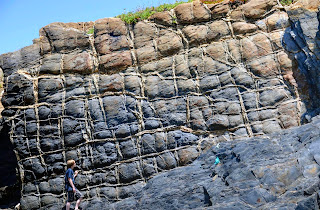fredag 12. august 2011
fredag 5. august 2011
Kinematics at high pressures
The basement region in SW Norway called Western Gneiss Region contains high-strain zones (mylonite zones) with deformation fabrics suggesting top-to-W or sinistral movements, particularly in the coastal parts. This was the leading edge of the Baltica craton during the Caledonian collisional history, subducted and shortly after obducted in a Himalayan-style setting, making it a classical area for studies of high-P metamorphism of continental crust and extensional deformation/orogenic collapse. The high pressures are indicated by widespread occurrences of eclogite, locally with coesite and micro-diamonds.
I took pictures of these porphyroclasts, showing examples of sigma- and delta-style porphyroclasts and porphyroclast imbrication (tiling).
See Figure 15.28 in my textbook for a closer explanation:
 |
| Eclogite, Nordfjord. Red-brown garnet, green omphacite, bluish kyanite. |
I took pictures of these porphyroclasts, showing examples of sigma- and delta-style porphyroclasts and porphyroclast imbrication (tiling).
 |
| Sigma-type porphyroclasts with tails not crossing the line of symmetry (reference line in lower figure). Top-to-left (W) sense of shear. Locality at Sandane. |
 |
| Delta-type porphyroclast where thin tails of recrystallized feldspar (suggesting high temperatures) crosses the line of symmetry. Top-to-left (W) sense of shear. Locality at Finnøy. |
 |
| Porophyroclast tiling or imbrication. Top-to-left (W) sense of shear. Locality at Sandane. |
See Figure 15.28 in my textbook for a closer explanation:
tirsdag 12. juli 2011
Portuguese boudins and folds
I visited Spain and SW Portugal last week and couldn't resist a short visit to the folded and boudinaged Carboniferous turbidites near Almograve, SW Portugal. Chocolate boudinage structures are not all that common, but here there are a few superb examples right on the beach. Chocolate boudinage implies uniform flattening, with extension along both X and Y strain axes (Figure 14.17a in my textbook).
Brittle and ductile: The boudinage is primarily a brittle process, as portrayed by quartz-filled fractures (white), while the folding is ductile (although very low temperature, probably <300 C). What a beautiful area to study cleavage formation, folding, fracturing and boudinage!
See Reber et al. (Tectonoph. 2010, v 493, 187-195) and Marques (Tectonics 2010) for more information.
Chocolate boudinaged fold limb.
Axial planar cleavage in metasandstone.
Brittle and ductile: The boudinage is primarily a brittle process, as portrayed by quartz-filled fractures (white), while the folding is ductile (although very low temperature, probably <300 C). What a beautiful area to study cleavage formation, folding, fracturing and boudinage!
See Reber et al. (Tectonoph. 2010, v 493, 187-195) and Marques (Tectonics 2010) for more information.
Chocolate boudinaged fold limb.
Axial planar cleavage in metasandstone.
Folded turbidites.
onsdag 22. juni 2011
New e-learning module: Foliations

I have posted a new e-module on my website on foliations (Chapter 12 of the book). It probably contains several errors at this point, so please send comments if you catch some of them, or if there are things that you think should be done differently. Link to the e-module
Binding problem resolved
Unfortunately, quite a few copies of the first printing of my book had a binding problem. Some copies were basically falling apart after some use! This problem, which was related to the glue or gluing process, was resolved with the 2nd printing (April 2011) which was sewn bound (as will future reprints). A 3rd printing is being prepared, and a number of errors will be fixed with that printing.
Starting a blog
This blog was made to get closer to the users of my book and the structural community in general. At this point it is an experiment, but I want to try this arena to get feedback and discussions around various aspects of the book that I will use during the preparation for the next edition, and also just to share and exchange opinions about things that have to do with structural geology.
Abonner på:
Kommentarer (Atom)





